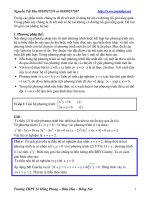Tài liệu tham khảo về phân tích rủi ro
Bạn đang xem bản rút gọn của tài liệu. Xem và tải ngay bản đầy đủ của tài liệu tại đây (164.57 KB, 68 trang )
Real vs. Nominal Rates
Fisher effect: Approximation
R = r + i or r = R - i
Example: r = 3%, i = 6%
R = 9% = 3%+6% or r = 3% = 9%-6%
Fisher effect: Exact
R −i
r =
;
or
1+i
0.09 − 0.06
Numerically: r = 2.83% =
1 + 0.06
1+R
1+r =
1+i
Rates of Return:
Single Period
HPR = P
1
− P0 + D1
P
0
HPR = Holding Period Return
P0 = Beginning price
P1 = Ending price
D1 = Dividend during period one
Rates of Return:
Single Period Example
Ending Price =
48
Beginning Price =
40
Dividend =
2
48 − 40 + 2
HPR =
= 25%
40
Characteristics of
Probability Distributions
1) Mean: most likely value
2) Variance or standard deviation
3) Skewness
* If a distribution is approximately normal, the distribution is described by
characteristics 1 and 2
Normal Distribution
s.d.
s.d.
r
Symmetric distribution
Measuring Mean: Scenario
or Subjective Returns
Subjective returns
E(r) =
s
∑p
i =1
i
⋅ ri
‘s’
= number of scenarios considered
pi = probability that scenario ‘i’ will occur
ri
= return if scenario ‘i’ occurs
Numerical example:
Scenario Distributions
Scenario
1
2
3
Probability
0.1
0.2
0.4
Return
-5%
5%
15%
4
5
0.2
0.1
25%
35%
E(r) = (.1)(-.05)+(.2)(.05)...+(.1)(.35)
E(r) = .15 = 15%
Measuring Variance or
Dispersion of Returns
Subjective or Scenario Distributions
2
Variance = σ =
s
2
∑ p(i) ⋅ [r(i) − E(r)]
i =1
Standard deviation = [variance]1/2 = σ
Using Our Example:
σ2=[(.1)(-.05-.15)2+(.2)(.05- .15)2+…]
=.01199
σ = [ .01199]1/2 = .1095 = 10.95%
Risk - Uncertain
Outcomes
p = .6
W = 100
1-p = .4
W1 = 150; Profit = 50
W2 = 80; Profit = -20
E(W) = pW1 + (1-p)W2 = 122
σ2 = p[W1 - E(W)]2 + (1-p) [W2 - E(W)]2
σ2 = 1,176
and
σ = 34.29%
Risky Investments
with Risk-Free Investment
p = .6
W1 = 150 Profit = 50
1-p = .4
W2 = 80 Profit = -20
Risky
Investment
100
Risk Free T-bills
Risk Premium = 22-5 = 17
Profit = 5
Risk Aversion & Utility
Investor’s view of risk
Risk Averse
Risk Neutral
Risk Seeking
Utility
Utility Function
U = E ( r ) – .005 A σ
A measures the degree of risk aversion
2
Risk Aversion and Value:
The Sample Investment
U = E ( r ) - .005 A σ
=
Risk Aversion
High
22%
A
2
- .005 A (34%)
2
Utility
5
-6.90
3
Low
1
4.66
16.22
T-bill = 5%
Dominance Principle
Expected Return
4
2
3
1
Variance or Standard Deviation
• 2 dominates 1; has a higher return
• 2 dominates 3; has a lower risk
• 4 dominates 3; has a higher return
Utility and Indifference
Curves
Represent an investor’s willingness to trade-off return and risk
Example (for an investor with A=4):
Exp Return
(%)
10
15
20
25
St Deviation U=E(r)-.005Aσ2
(%)
2
20.0
2
25.5
2
30.0
2
33.9
Indifference Curves
Expected Return
Increasing Utility
Standard Deviation
Portfolio Mathematics:
Assets’ Expected Return
Rule 1 : The return for an asset is the probability weighted average return in all scenarios.
E(r) =
s
∑p
i =1
i
⋅ ri
Portfolio Mathematics:
Assets’ Variance of Return
Rule 2: The variance of an asset’s return is the expected value of the squared deviations from the expected return.
2
σ =
s
∑p
i =1
i
2
⋅ [ri − E(r)]
Portfolio Mathematics:
Return on a Portfolio
Rule 3: The rate of return on a portfolio is a weighted average of the rates of return of each asset comprising the portfolio, with the portfolio
proportions as weights.
rp
= w1r1 + w2r2
Portfolio Mathematics:
Risk with Risk-Free Asset
Rule 4: When a risky asset is combined with a risk-free asset, the portfolio standard deviation equals the risky asset’s standard deviation multiplied
by the portfolio proportion invested in the risky asset.
σ
p
= wrisky asset × σrisky asset
Portfolio Mathematics:
Risk with two Risky Assets
Rule 5: When two risky assets with variances
σ12 and σ22 respectively, are combined into a portfolio with portfolio weights w1 and w2,
respectively, the portfolio variance is given by:
σ
p
2
= w12 σ12 + w22 σ22 + 2w1w2Cov(r1, r2)
Allocating Capital Between
Risky & Risk Free Assets
Possible to split investment funds between safe and risky assets
Risk free asset: proxy; T-bills
Risky asset: stock (or a portfolio)
Allocating Capital Between
Risky & Risk Free Assets
Examine risk/return tradeoff
Demonstrate how different degrees of risk aversion will affect allocations between risky and risk free assets
The Risk-Free Asset
Perfectly price-indexed bond – the only risk free asset in real terms;
T-bills are commonly viewed as “the” risk-free asset;
Money market funds - the most accessible risk-free asset for most investors.
Portfolios of One Risky Asset
and One Risk-Free Asset
Assume a risky portfolio P defined by :
E(rp) = 15% and σp = 22%
The available risk-free asset has:
rf = 7% and σrf = 0%
And the proportions invested:
y% in P and (1-y)% in rf
Expected Returns for
Combinations
E(rc) = yE(rp) + (1 - y)rf
rc = complete or combined portfolio
If, for example, y = .75
E(rc) = .75(.15) + .25(.07)
= .13 or 13%









